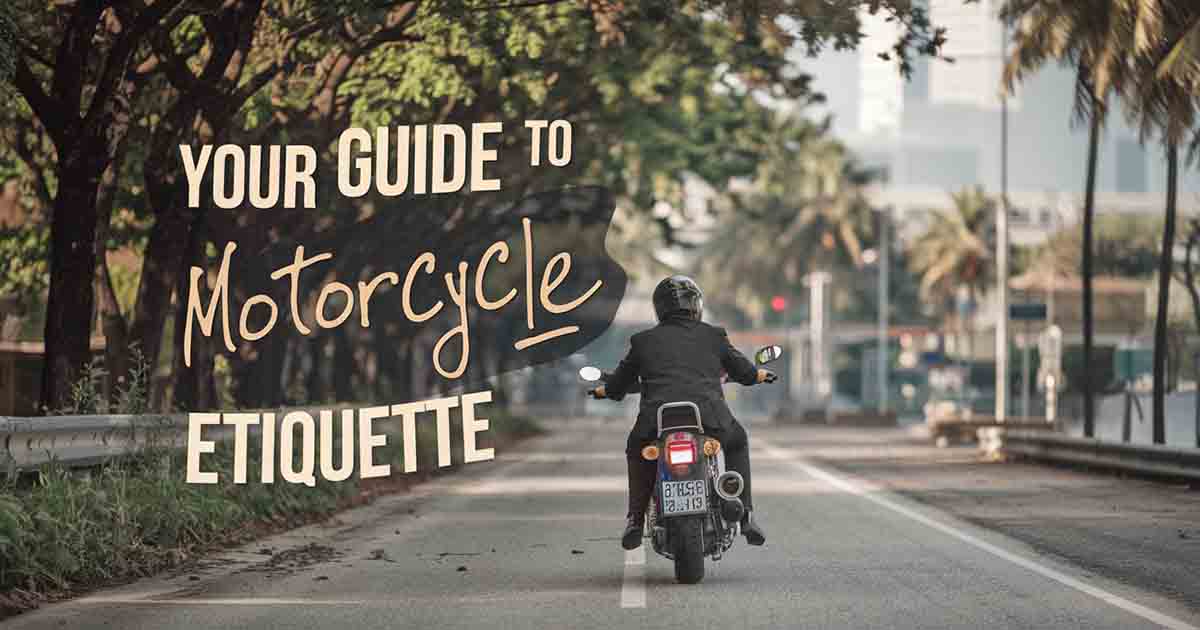8 Unwritten Rules of the Road Every Motorcyclist Should Know

What are the rules for riding a motorcycle?
Just like any sport or hobby, riding a motorcycle comes with two sets of rules—the written and the unwritten, and it’s a lot easier to learn the former than the latter. Unfortunately, there are no classes, guidebooks or seminars on the unwritten laws of riding. Oh, and you definitely won’t be tested on them when you go to get your motorcycle license. Learning the rules of the road and biker culture takes years of cruising and interacting with other two-wheel enthusiasts. But the following list can help you get a glimpse into what you’ll learn when you start to master the road.
Key Takeaways
-
-
A. Don’t Ask to Ride Someone Else’s Bike
Referred to as The Natural Law of Motorcycling, this is one of the rules you’re going to want to take seriously if you’re new to the community. Asking to take someone else’s motorcycle for a spin puts them in the position of having to say no, so just don’t do it. No one wants to loan another rider his or her bike because it’s a big liability, and riders have things just the way they like them, not the way a random borrower might. Plus, it’s just bad manners all-around.
- Pro Tip: Want to try a new bike? Head to a dealership or bike rental service to experience different models without putting friendships on the line.
-
B. Always Alert Fellow Riders of Hazards
Many of the unwritten laws of riding come down to the same concept: look out for one another. Whenever possible, keep your fellow bikers in the know about what’s ahead—a speed trap, a particularly gnarly pothole, a traffic jam, deer—either via motorcycle Bluetooth communication if you’re cruising with a group of riders you know or through old-school hand signals (see below) to keep strangers in the other lane safely clued in to what’s ahead.
- Common Hand Signals:
- Tap on the helmet: There’s a police officer or speed trap ahead.
- Pointing at the ground: Hazard in the road—watch out for debris or a pothole.
-
C. Know Rider-to-Rider Communication
Even if it’s your first day as a licensed biker, you already know that there’s a secret language that goes on, bike to bike, out on the road. But you may not know that there are both written and unwritten hand signals you need to know. Of course, there are the ones you learned in driver’s ed, such as a straight, extended arm to signal a left turn or a folded-down arm to signal a stop. But then there are the ones you learn through years of communication with fellow bikers, like a tap on the helmet to alert your fellow riders of a cop or speed trap ahead. Don’t worry if you don’t get it all on your first ride—this is a language you pick up as you go.
-
| Biker Signal | How to Execute | What It Means |
|---|---|---|
| Left Turn | Extend your left arm straight out. | Indicates the rider is turning left. |
| Right Turn | Extend your left arm out and bend it upward at a 90-degree angle. | Indicates the rider is turning right. |
| Stop | Extend your left arm out and bend it downward at a 90-degree angle. | Indicates the rider is stopping or slowing down. |
| Speed Up | Raise your left arm with a fist, then move it upward repeatedly. | Indicates the group should increase speed. |
| Slow Down | Extend your left arm down and move your palm up and down. | Indicates the group should reduce speed. |
| Hazard in Road (Left) | Point with your left hand toward the hazard. | Warns riders of a hazard on the left side of the road. |
| Hazard in Road (Right) | Point with your right foot toward the hazard. | Warns riders of a hazard on the right side of the road. |
| Follow Me | Raise your left arm and point forward. | Signals the group to follow the lead rider. |
| Single File | Raise your left hand with one finger extended upward. | Signals riders to form a single file line. |
| Double File | Raise your left hand with two fingers extended upward. | Signals riders to form a double file line. |
-
-
-
1. Should You Wave at Your Fellow Riders?
Another important hand signal to know? The wave. Legend has it that the bike-to-bike wave started back in 1904 when William Harley and Arthur Davidson (yes, that Harley and Davidson) passed one another and gave a friendly wave. There are many variations on the biker’s salute, with the most common being two or three fingers pointed downward at a 45-degree angle, but there are tons of unique and regional versions out there. The motorcycle wave is all about showing solidarity and forging a connection among your fellow riders. -
2. Stop to Help a Fellow Rider?
Many of the unwritten rules of the road for bikers center around helping each other and forging a sense of community. You always want to make sure you stop and assist a fellow biker—or, any motorist, for that matter—in need. If you see someone who may be in distress or if you’re traveling through a dangerous area, such as a steep mountain pass or a rural road where there’s no gas station for miles in either direction, you may want to flash a thumbs up or down to make sure other travelers know you’re okay and vice versa. However, always assess the situation for your own safety first. If the area seems unsafe or suspicious, keep your distance and offer assistance by calling emergency services instead. Your safety should always come first.
-
3. How Do You Respect the Road and Others?
As bikers, we know we stand out from the typical commuter rocking his grocery-getter, but we shouldn’t be at odds with him. Always practice defensive driving and make sure to give other cars and motorcycle riders plenty of room. Don’t hesitate to help them out by letting them in or waving them ahead of you. Simple gestures of courtesy can go a long way in fostering a positive relationship between bikers and other motorists.
Just remember that drivers may have trouble seeing you or staying out of your lane, so ride defensively and remain visible whenever possible. Use reflective gear, maintain a safe following distance, and avoid lingering in blind spots. Anticipate unpredictable behavior from other drivers, especially in heavy traffic or poor weather conditions, and always be prepared to react calmly and safely.
- Additionally, respect speed limits, obey traffic laws, and avoid weaving in and out of lanes, as this can create tension on the road. When riding through residential areas or near pedestrians, lower your speed and reduce noise levels to show consideration for others. Being a responsible and respectful rider not only keeps you safe but also improves the public image of motorcyclists, contributing to a safer and more harmonious road experience for everyone.
- Quick Tip: Stay out of blind spots and make eye contact with drivers when possible. Wearing bright gear and using reflective decals can also increase your visibility.
-
4. Why Stay in Formation During Group Rides?
This is one situation where a biker-to-biker headset really comes in handy. When you’re riding as a group, you need to stay in a safe, roomy formation—ideally, in a staggered line with a two-second distance between you and the rider directly in front of you—in order to keep everyone together without crowding or encroaching on the rest of traffic. It can be difficult to maintain a neat formation when you’re going for longer group rides, but knowing your hand signals or having a reliable Bluetooth system can go a long way in this situation. - Safety Tip: Two seconds of distance between you and the rider in front of you will give you enough time to react if they brake suddenly or swerve to avoid an obstacle.
-
5. Why Are Bikers Good Community Members?
Know that you can rely on your fellow riders; they’re generally not dangerous gang members. Many motorcycle clubs dedicate significant time and effort to raising money for charitable causes in the community, from organizing toy drives for children to supporting veterans and local hospitals.
Additionally, bikers often band together to support one another during emergencies or accidents, demonstrating a strong sense of camaraderie. Most importantly, by simply mounting a bike, you become an automatic member of that community, which comes with a responsibility. Following laws, being courteous to others, and assisting fellow riders in need help foster a positive image of motorcyclists.
Engaging with the community, participating in local events, and advocating for motorcycle safety also contribute to making bikers a valued part of society. When you ride with respect and uphold the values of your community, you’ll be a welcome addition to any region’s motorcycle culture.
-
The Most Important Rule? Learn as You Go
One of the biggest mistakes young and novice riders tend to make is pushing themselves too far beyond their limits too early. This applies to everything from taking hairpin turns at high speeds to learning the best way to convey important information to other riders on the highway. As you enter the world of riding, keep your ears and eyes open so you pick things up as you go and never find yourself in a dangerous, awkward or uncomfortable situation.
Remember: Every mile on the road is a learning opportunity, so stay humble, ride safely, and embrace the culture.
Final Thoughts from the Road
Riding a motorcycle isn’t just about getting from point A to point B—it’s about the freedom, the connection with the road, and the sense of community with fellow riders. From learning the unspoken rules to mastering hand signals and riding in formation, every experience makes you a better rider. The road teaches you lessons you can’t learn anywhere else. Whether you’re helping a fellow rider in need or sharing a wave with someone passing by, it’s all part of what makes motorcycling so special.
Happy riding, and may every mile be a safe one!
It Takes Just Seconds to Get a Quote
If you’re ready to take your motorcycle distribution to the next level, get a quote today and see how Motorcycle Shippers can help you optimize your operations. With their expertise and experience, you can be confident that your bikes will reach their destinations quickly, safely, and efficiently, allowing you to focus on what you do best—growing your business.
More Great Resources from our Team to You
CHECKLIST FOR BUYING A USED MOTORCYCLE
SHOULD YOU TRUST CONSUMER REPORTS MOTORCYCLE RELIABILITY STUDY?
HOW TO FIND CHEAP MOTORCYCLE TRANSPORT (AND AVOID HIDDEN COSTS)
HOW TO TRANSPORT A MOTORCYCLE | GUIDE WITH COST
Posted By
Clint Lawrence, founder of Motorcycle Shippers. Helping give riders more freedom to enjoy the bikes they love.
-


